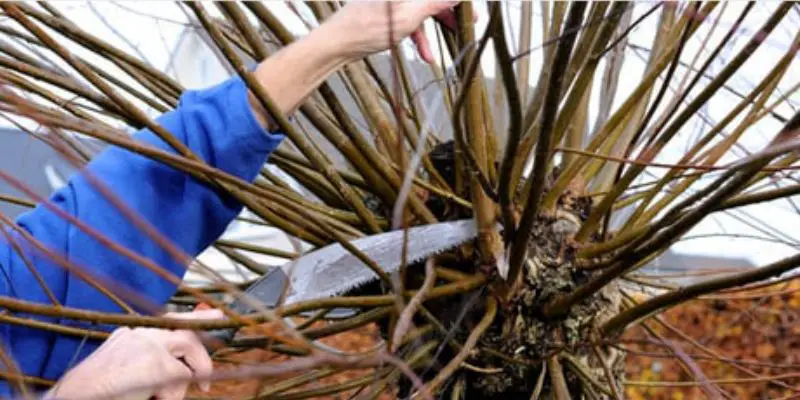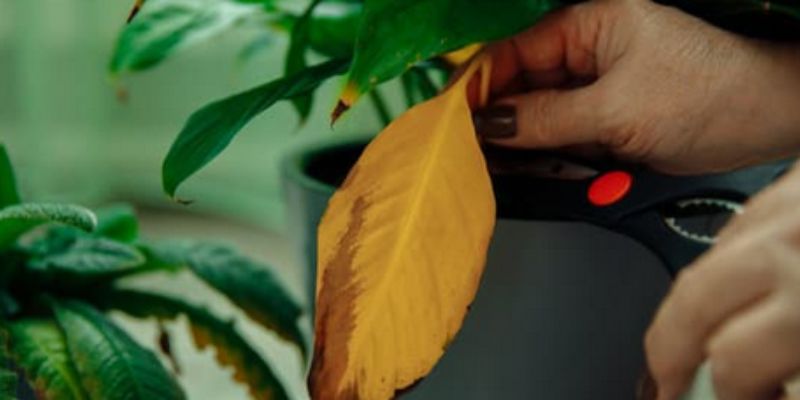If you have a weeping willow tree in your yard, you likely admire its graceful, cascading branches and the dappled shade it provides on a hot summer day. But without occasional pruning, your willow’s branches can become tangled, crossing each other and rubbing against the trunk. Proper pruning keeps your willow tree healthy, maintaining its shape and beauty. With the right pruning techniques, you can help your willow tree thrive for years to come. Read on to learn how to prune willow tree.
When to Prune a Willow Tree
The best time to prune a willow tree is late winter or early spring, before the buds swell and new growth begins. Willows bleed sap profusely if pruned during the growing season, which can weaken the tree. Pruning in late winter or early spring avoids this problem.
It’s best to wait until the coldest part of winter has passed before pruning willows. Severe cold can damage fresh pruning wounds. Aim to prune willows in February or March in most climates.
Signs It’s Time to Prune Your Willow
How can you tell if your willow tree needs pruning? Here are some signs that it’s time to get out the pruning shears:
- Branches rubbing together or crisscrossing each other
- Branches growing towards the center of the tree
- Lower branches drooping to the ground
- Dead, damaged, or diseased wood
- Branches blocking walkways, driveways, or views
- A misshapen or uneven canopy
If you notice any of these issues, it’s time to do some pruning to keep your willow healthy and looking its best.
How to Prune Willow Tree
Pruning a willow tree doesn’t need to be complicated or intimidating. Here is a step-by-step guide to pruning your willow properly:
1. Gather Your Pruning Tools
You’ll need the following basic pruning tools:
- Bypass hand pruners for smaller branches
- Lopping shears for thicker branches
- Pruning saw for large branches and limbs
- Pole pruner or pole saw for high branches
- Ladder or work platform for reaching high branches
Make sure your tools are clean and sharp. Dull blades can crush rather than cut branches cleanly. Disinfect tools before use with isopropyl alcohol to prevent spreading disease.
2. Remove Suckers and Water Sprouts
Begin by removing any suckers growing from the base of the trunk. Suckers are fast growing vertical shoots that divert energy from the rest of the tree.
Also remove water sprouts, which are shoots that grow straight up from branches. Like suckers, water sprouts waste the tree’s energy. Prune water sprouts at their point of origin.
3. Thin Out Inner Branches
A common willow pruning task is thinning out branches growing towards the inside of the canopy. Removing these inward-growing branches helps sunlight and air penetrate to the entire tree.
Identify branches that rub or cross each other and remove the weaker of the two branches. Make thinning cuts just above lateral buds or branches. This encourages new outward growth.
4. Remove Broken or Diseased Branches
Scan the canopy for dead, damaged, or diseased branches. These should be removed as soon as possible. Cut damaged branches just beyond the point of injury or infection to avoid spreading disease.
Pruning out dead branches also prevents decay from creeping downwards from the deadwood into healthy wood. Make clean pruning cuts close to the trunk or nearest healthy branch.
5. Shape and Contain the Canopy
Willows often need pruning to control size and shape. Unchecked, willows can expand to over 70 feet tall and 50 feet wide.
Pruning to limit the canopy prevents your willow from encroaching on power lines, buildings, or blocking desired views. Trim branches as needed to reduce the overall size and shape the canopy.
You can also prune to lift low hanging branches for clearance beneath the tree. Remove inner branches growing towards the center of the canopy to allow more light penetration.
Aim for an oval or vase-shaped canopy, wider at the bottom and more narrowly tapered at the top. This form maximizes light exposure.
How to Make Proper Pruning Cuts
Where and how you make pruning cuts is critical for protecting tree health. Here are some tips:
- Always cut just outside the branch collar – the swollen area where a branch joins a larger limb or trunk. Cutting into the branch collar removes the tree’s natural defenses against decay.
- Avoid leaving branch stubs. Stubs die and can become entry points for pests and disease. Make cuts close to the trunk or nearest healthy lateral branch.
- Use a three cut method for large branches to prevent bark tearing. Make an undercut 6-12 inches from the trunk, then cut down from the top until the branch breaks cleanly at the undercut. Make a final trim just outside the branch collar.
- Disinfect pruning tools between cuts to prevent spreading disease. Soak tools for at least 30 seconds in 70% isopropyl alcohol.
- Never top trees or prune heavily. Removing too much live wood stresses trees and can lead to sunscalding and decay.
Clean Up Debris
Gather up and dispose of all pruned branches, twigs and leaves. Diseased debris can harbor pests and pathogens that may reinfect the tree.
Cleaning up debris also improves airflow and light penetration through the canopy. This helps remaining branches and leaves thrive.
How Often to Prune a Willow Tree
Weeping willows generally need yearly pruning to maintain their shape and health. Here are some guidelines:
- Young trees, under 5 years old, need only light pruning. Remove suckers, water sprouts, and any branches that rub or cross each other.
- Mature willows, over 5 years old, need moderate pruning every 1-2 years. Thin dense growth, shape the canopy, and remove dead or damaged branches.
- Neglected willows with overgrown canopies require gradual renewal pruning over 2-3 years. Never remove more than 30% of live wood at once.
- Monitor for pests like borers and diseases like canker to know if additional pruning is needed. Remove infested branches ASAP to prevent spread.
- After pruning, monitor the cuts over the following weeks. Apply tree wound paint to any cuts bigger than 1 inch across to prevent decay organisms from entering.
Signs Your Willow Needs Pruning
Some clues your willow is due for pruning:
- Small branches growing from larger limbs (water sprouts)
- Vertical shoots from the trunk base (suckers)
- Inward growing branches
- Branches rubbing together
- Lopsided or uneven canopy
- Dead or damaged branches
- Low hanging branches blocking walkways or views
Pruning Young Willow Trees
Pruning is especially important in a willow’s first 5 years as it establishes. Here are some key points:
- Allow the central leader (the main upright stem) to grow mostly unchecked to build trunk thickness.
- Prune only to remove suckers from the base, water sprouts along branches, and any branches that rub or cross each other.
- Wait to shape and thin the canopy until the tree is 5 years or older.
- Monitor for pests and diseases and remove any infested branches immediately. Young trees are more vulnerable to infections.
- Stake the tree if needed to prevent wind damage. Remove ties and stakes after 1-2 years once the trunk is strong enough to stand alone.
- Water young willows regularly, especially during drought. Soak the entire root zone once a week if rain is lacking.
Follow these guidelines, and your young weeping willow will quickly establish for years of beauty and enjoyment.
When to Call an Arborist
Pruning mature willow trees can be challenging. Large branches can be cumbersome to safely cut and lower to the ground. Power lines often run through willow canopies, adding risk.
Pruning willows over 30 feet tall is best left to professional arborists. They have the experience, equipment, and insurance to prune large trees safely.
Here are signs it’s time to call in an arborist to prune your willow:
- Tree height exceeds 30 feet
- Major limbs larger than 4-6 inches in diameter need removal
- Branches are entangled in overhead power lines
- The willow canopy has become severely overgrown and uneven
Hiring a professional arborist protects your safety and your tree’s health. Ask for a certified arborist who carries proper insurance. Be sure to get a detailed contract in writing before work begins.
How to Prune Willow Tree – Avoiding Common Pruning Mistakes
It’s easy to make mistakes pruning willow trees. Here are some common errors to avoid:
- Never top or liontail trees. Removing large branches and leaving only tufts of foliage can lead to sunscalding, decay, and unhealthy regrowth.
- Don’t prune in summer. Willows bleed sap heavily when pruned during growth. Stick to late winter pruning.
- Leaving branch stubs invites insects and fungi. Always cut to a lateral branch or trunk.
- Overpruning causes water sprout regrowth. Remove no more than 30% of live wood per year.
- Using improper tools tears bark and wood. Invest in quality bypass pruners, loppers, and saws. Keep blades sharp.
- Failing to clean tools spreads disease between cuts. Disinfect pruners between each cut with isopropyl alcohol.
How to Prune Willow Tree: Final Tips
A few final tips to review on pruning willow trees:
- Time pruning in late winter before bud break to avoid sap bleeding.
- Remove inward growing branches, suckers, water sprouts, and deadwood.
- Lift low branches for clearance as needed. Shape and thin the canopy to improve form.
- Make proper cuts just outside branch collars to avoid decay organisms entering.
- Disinfect tools between each cut to prevent disease spread.
- Call a professional arborist for tall trees or major limb removal.
- Monitor young trees and prune lightly to train structure.
Follow these best practices and your graceful weeping willow will thrive for years of beauty. Happy pruning!

Michael Glenn is a certified arborist and horticultural expert with over 15 years of experience in the landscape industry. His passion for plants and trees has led him to become a sought-after authority on pruning and trimming techniques. Glenn’s in-depth knowledge of proper pruning methods, timing, and tools has helped countless homeowners and professionals maintain healthy, aesthetically pleasing gardens and landscapes.
In addition to sharing his pruning expertise through practical tips, step-by-step guides, and expert advice, Glenn is also a respected author of pruning tool buying guides. His comprehensive reviews and comparisons ensure readers can make informed decisions when investing in quality loppers, pruning shears, saws, and other essential equipment. With a deep understanding of plant biology and sustainable practices, Glenn’s writing empowers audiences with the knowledge needed to properly care for green spaces.





